Louisville Forecast 2012
Sanders Chair in Business, Indiana University Southeast, New Albany
At the start of 2011, the Louisville metro was on track for positive job growth. From January to April, the region added about 11,000 non-farm jobs, and the region’s unemployment rate had declined by half of a percentage point. The start of the year’s second quarter, however, was the beginning of an overall slowdown. From May to August, non-farm payrolls added no new jobs, and the unemployment rate only declined by three-tenths of a point. Since August, employment growth has resumed, and the region should continue to see gradual growth through 2012.
Employment
The Louisville metro continues to be down approximately 22,000 non-farm payroll jobs since the beginning of the Great Recession. Stronger manufacturing growth over 2011 helped partially erase the recession jobs deficit, but this growth is now beginning to slow (see Figure 1). Consequently, the region will continue to see positive job growth, but only at a slow rate.
Figure 1: Louisville Employment and Manufacturing Growth, March 1991 to September 2011
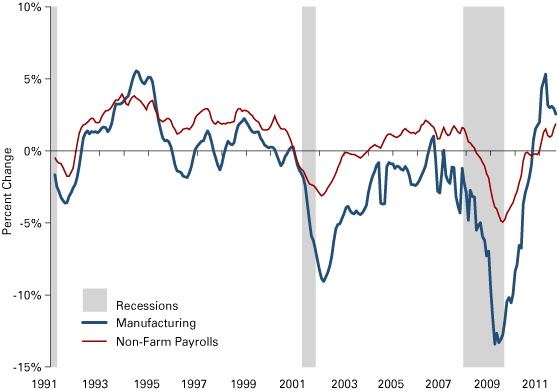
Source: FactSet
Unemployment Rate
The Louisville metro’s unemployment rate appears to have reached a floor. After declines earlier in the year, the region’s unemployment rate settled around the 9 percent level (see Figure 2).
Figure 2: Louisville Unemployment Rates, March 1990 to September 2011
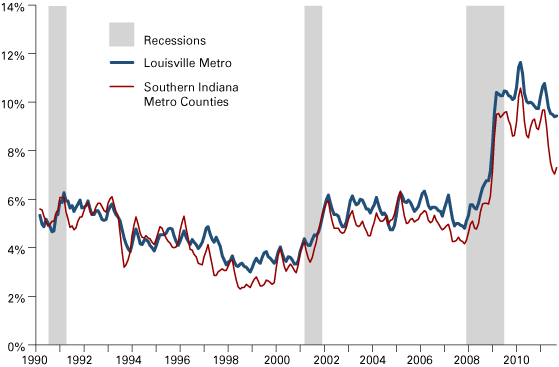
Source: FactSet
As employment and the labor force continue to grow, the unemployment rate will not see significant declines from the 9 percent level since both the labor force and employment will grow at approximately the same rate. The most recent data point saw the unemployment rate increase back up to 9.6 percent. However, the underlying trend in job creation was quite positive.
On the other hand, the Southern Indiana metro counties (Clark, Floyd, Harrison and Washington) have enjoyed rates less than the region’s average, with some counties experiencing unemployment rates around the 7 percent level. A favorable combination of growing employment and labor force is contributing to the overall rate decline. Hence, the outlook for Southern Indiana’s unemployment rate is continued gradual improvement, with the area’s rate settling to a level just above 6 percent.
Unemployment Claims
Southern Indiana’s new claims for unemployment continue to show improvement from the escalating levels of 2009 (see Figure 3). The latest readings indicate that claims in the metro counties appear to have settled with no noticeable trend of higher or lower levels.
Figure 3: Unemployment Claims in Southern Indiana Metro Counties, January 2009 to October 2011
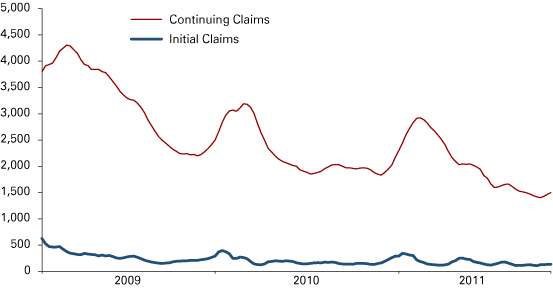
Note: Data are four-week moving averages.
Source: FactSet
Manufacturing
Manufacturing contributed to massive employment losses for Indiana during the Great Recession and subsequently contributed to employment gains. Following the Great Recession, manufacturing drove Indiana’s economic recovery due to inventory restocking needs following demand-driven cutbacks in production. Policymakers rejoiced over manufacturing gains, and Indiana was often showcased as a jobs leader nationally.
Perhaps this job growth was short lived. As the nation exits the inventory restocking phase, demand will be necessary in order to sustain earlier gains in manufacturing. Subpar growth in gross domestic product and slowing growth in Europe and emerging market economies suggest that the demand will not be sufficient to sustain these gains. Consequently, manufacturing growth has slowed and will likely see continued slow growth during 2012.
Services
Service sector growth has bounced back since the depths of the Great Recession, but has not been sufficient to erase the overall jobs deficit. For example, retail employment continues to be down 4,500 from prior to the last recession. Additionally, transportation and utilities, a significant component of the metro economy, has yet to bounce back from the 4,200 lost positions since September 2007. As consumer spending on leisure and business travel continues to recover, leisure and hospitality employment continues its recovery as well, adding 3,000 jobs since last year. Some of the most impressive growth can be attributed to the professional and business services sector (see Figure 4). From September 2010 to September 2011, 8,300 jobs were added to this overall employment barometer. On the downside, however, most of the professional and business services gains are attributed to temporary labor services, an indication of continued slack in the regional labor markets. The most resilient service sector, educational services and health care, continues to be in positive territory—but the most recent numbers point to a leveling of growth.
Figure 4: Louisville Services Employment, January 2007 to September 2011
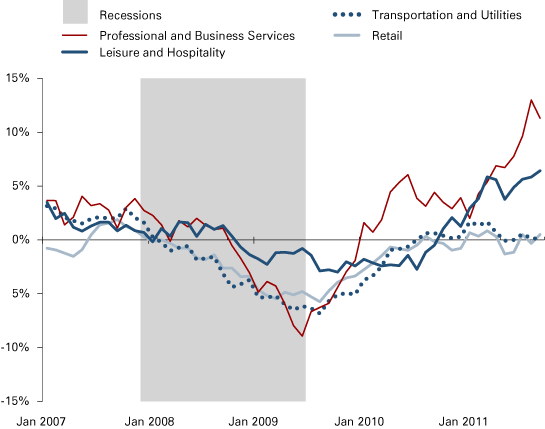
Source: FactSet
Housing
Housing continues to struggle. Permits remain well below trend, and home prices remain soft. Challenges faced in housing will continue to adversely impact consumer confidence and subsequent consumer spending. No significant housing recovery can be expected this year. Consequently, housing will continue to weigh on consumer sentiment, adversely affecting overall consumer demand.
Figure 5: Louisville Single-Family Permits and Change in House Price Index, March 1995 to August 2011
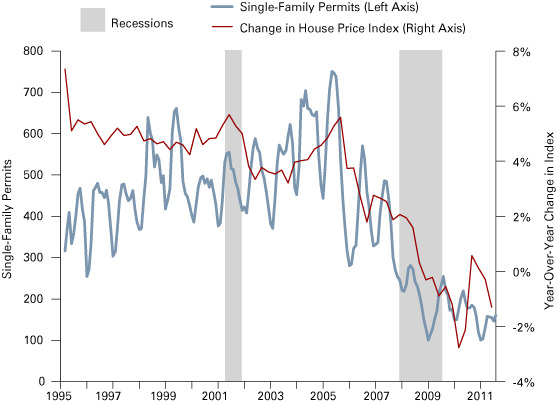
Source: FactSet
Outlook
The Louisville metro will continue to see job growth, but only gradually. As a result, the region’s unemployment rate will continue to hover above 8 percent. Housing should also see a gradual turnaround, but at a very subdued pace. Building permits and construction jobs will also see increases, but likewise at a very slow pace. The region should expect to see gradual improvement in the service sectors as consumers continue to experience an overall recovery and become more confident. Southern Indiana will see higher employment growth than the overall metro area, and its unemployment rate will remain at levels lower than the region.
Also in this Issue…
- Outlook for 2012
- International Outlook for 2012
- U.S. Outlook for 2012
- Financial Outlook for 2012
- Housing Market Outlook for 2012
- Indiana's Outlook for 2012
- Indiana's Agricultural Outlook for 2012
- Anderson Forecast 2012
- Bloomington Forecast 2012
- Columbus Forecast 2012
- Evansville Forecast 2012
- Fort Wayne Forecast 2012
- Gary Forecast 2012
- Indianapolis-Carmel Forecast 2012
- Kokomo Forecast 2012
- Lafayette Forecast 2012
- Louisville Forecast 2012
- Muncie Forecast 2012
- Richmond Forecast 2012
- South Bend and Elkhart Area Forecast 2012
- Terre Haute Forecast 2012




